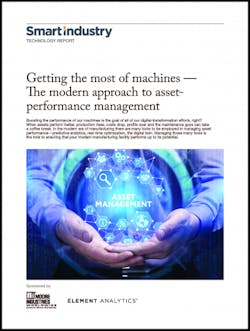Over the last few decades, the introduction of industrial Ethernet and wireless networks
in process-manufacturing plants and automation facilities has meant that data exchange within a facility (and even throughout global corporate networks) is becoming commonplace. The challenge for legacy plants is to find inexpensive and convenient ways to take advantage of the data already available in existing field devices.
With more than 40 million installed HART devices worldwide, there is no other protocol that has such a massive installed base. HART (Highway Addressable Remote Transducer) is a digital protocol that was designed to allow transmitters to simultaneously transmit digital data and their 4-20mA process signal over traditional plant-installed copper twisted pair. The HART digital signal often contains additional process measurements and other variables that may include instrument status, diagnostic data, alarms, calibration values and alert messages.
Many HART field transmitters are hard at work measuring process parameters and producing a 4-20mA signal that is being used for process control by a BPCS, PLC or some other control system. In many cases, HART instruments were installed simply because they could be configured and diagnosed easily with a HART handheld communicator (HHC). There are several reasons that the rest of the HART data often goes unused—the prohibitive cost of installing a plantwide HART-monitoring system, the lack of familiarity with alternatives, etc.
Many PLC and BPCS cards that are installed in legacy systems don’t have the capability to read the HART data that is superimposed on the 4-20mA signal. However, each vendor usually has an alternative card that is more expensive or offers a full upgrade path for the CPU/controller and input cards that read HART. HART multiplexers are also common, but typically their interface is a custom RS-422, RS-485 or RS-232 serial connection which is configured for a particular vendor’s hardware interface, asset-management system or control system.
Some PLC and BPCS companies offer slide-in chassis-type gateway cards that read the HART data and offer a proprietary backend communication connection to the system. Usually each of these options is costly and, therefore, avoided. The most expensive/most specific HART interface to have is one written by a programmer, which can then be customized to exact user and hardware specifications.
However, standalone HART gateways frequently provide the most economical pathway to extracting HART data from field devices, making the information readily available to higher-level systems. These products, like Moore Industries’ HCS or HES, can offer multiple channels or ports that enable several HART devices to be connected and may also allow HART devices to be multi-dropped (up to 16 per twisted pair) for maximum data concentration. Their output is usually an open industrial protocol such as MODBUS/RTU (RS-485) or MODBUS/TCP.
MODBUS is one of the most widely installed and supported protocols in plant networks. MODBUS RTU communicates over RS-485 and MODBUS/TCP uses the same protocol but over Ethernet. A MODBUS network can also be set up fairly easily to work over a wireless link. Essentially, the wireless link replaces the twisted pair or Ethernet cables. Many wireless radio manufacturers support the MODBUS protocol, which makes implementation by both host computer and field-device manufacturers quick and abundant due to MODBUS’ popularity and royalty-free implementation.
The HART data is digitally mapped to the MODBUS memory map, where it can then be polled by a PLC or DCS that is acting as the MODBUS Master. Multi-dropping HART gateways onto a single MODBUS master can, essentially, provide a scaled-down asset-management system for a fraction of the cost.
In today’s world of asset management, remote diagnostics and advanced control, many plants are looking for an economical way to extract that digital information. Taking critical plant-floor data from smart HART field devices and sharing it with higher level control and information systems within a manufacturing facility (and further) is no longer difficult or expensive. HART-interface devices, like the HCS and HES, with open industry protocols and ease of programming, provide a quick and seamless way to share process data.
Tina Todd is director of engineering at Moore Industries Worldwide.




